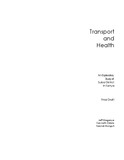| dc.description.abstract | This case study, undertaken in Suba District in Nyanza Province, Kenya, examined
mobility and health linkages. The study areas were selected based on key health and
transport indicators notably: areas near Ruma National Park which has long walking
distances to goods and services and motorized transport services, Mufangano Island
which is two hours away by boat from the main market and health facilities, and the
fishing villages in Ringiti Island. The study assessed and analyzed issues related to
maternal health, malaria, and gender disparities in relation to mobility using
combination of qualitative and quantitative research methods was used to collect and
analyze data. The approach included review of relevant literature and resources
followed by a participatory appraisal of key respondents. The key tools used
included Focus Group Discussions and assessment of needs and ranking of
priorities.
The study makes some interesting findings. Overall, the main barriers in transport to
accessing health institutions in Suba are lack of transport services (including boat
services), lack of money for transport services when the services are available, and
lack of specialized affordable method of carrying patients who are not able to walk.
People also face risk walking to health institutions especially in areas that are near
the Ruma National Parks. Walking across mountainous terrain with a sick person
was reported to be a burden.
In Locations covered in the study (Gembe, Wakianga/Waware, Kamasengre,
Kawanga, Kaksingri East, Ruma, Gwassi West and Mbita Township) the people
have adapted self medication, including drinking water, massages and purchase of
over the counter medication to deal with common interventions for mild illnesses
and cope with transport difficulties. A number of intermediate forms of transport
have been developed to improve access and provide means of transport in cases of
severe medical conditions. These include use of bed stretchers, wheelbarrows,
bicycle, handcarts, as well as use of boats for water transport.
Localized conditions, for example, fear of wild animals in areas bordering Ruma
National Park notwithstanding, no overall pattern in terms of transport challenges or
preferred interventions is discerned from any of the study areas characterized as
savannah, island or mountainous. The same is true when the data is disaggregated
and analyzed by gender. As a result, this exploratory study marks the birth of further
detailed research on the relationship between transport and health in and possible
transport and mobility interventions that may be considered in attempted to improve
access to health in Suba and indeed the whole country. | en |

